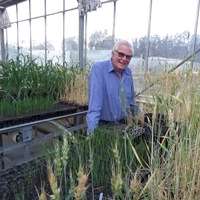Blast from the past gives wheat a boost

(Phys.org) —Half a century after conducting a plant experiment as part of his undergraduate Honours project, Adjunct Professor John Hamblin from The University of Western Australia's Institute of Agriculture (IOA) expects to see very positive results in 2015.
What makes his story fascinating is the enormous lapse of time since the initial experiment and the casual event which inspired him to revisit the idea.
In the mid 1960s the enthusiastic student bred an Arabidopsis wild type and a variegated mutant, to see if the difference in chlorophyll levels per unit leaf weight in the parent plants would impact on the progeny.
"The F1 hybrid showed high vigour - twice that of the better parent," Professor Hamblin recalled. "As a result of growing the plants in relatively low light, back then, I called the result the Goldilocks effect. The level of chlorophyll in the F1 leaves was obviously 'just right' for that environment."
By chance, Professor Hamblin came across a publication in 2011 which supported his hypothesis that reduced levels of chlorophyll might increase crop yields.
"Possible reasons include better light distribution in the crop canopy and less photochemical damage to leaves," he explained.
With the advent of new tools which can sort genetic material and test Professor Hamblin's hypothesis that reduced chlorophyll per unit leaf area is a pathway to higher yields, he recently decided to repeat his student experiment. He used the new tools to analyse the chlorophyll per unit leaf area in a range of wheat varieties.
"There were two aims," Professor Hamblin said. "Firstly to establish a system by which we could screen plants confidently; secondly, to identify varieties that differ significantly and consistently. We succeeded far beyond our expectations."
In key findings, two wheat genotypes were identified as having consistent and contrasting levels of leaf chlorophyll content: DBW10 with the highest chlorophyll content and Transfer with the lowest amount.
The research, by Professor Hamblin and colleagues Associate Professor Katia Stefanova at the IOA and Dr Tefera Tolera Angessa from UWA's School of Plant Biology, was recently published by the journal PLoS ONE.
Journal information: PLoS ONE
Provided by University of Western Australia
















